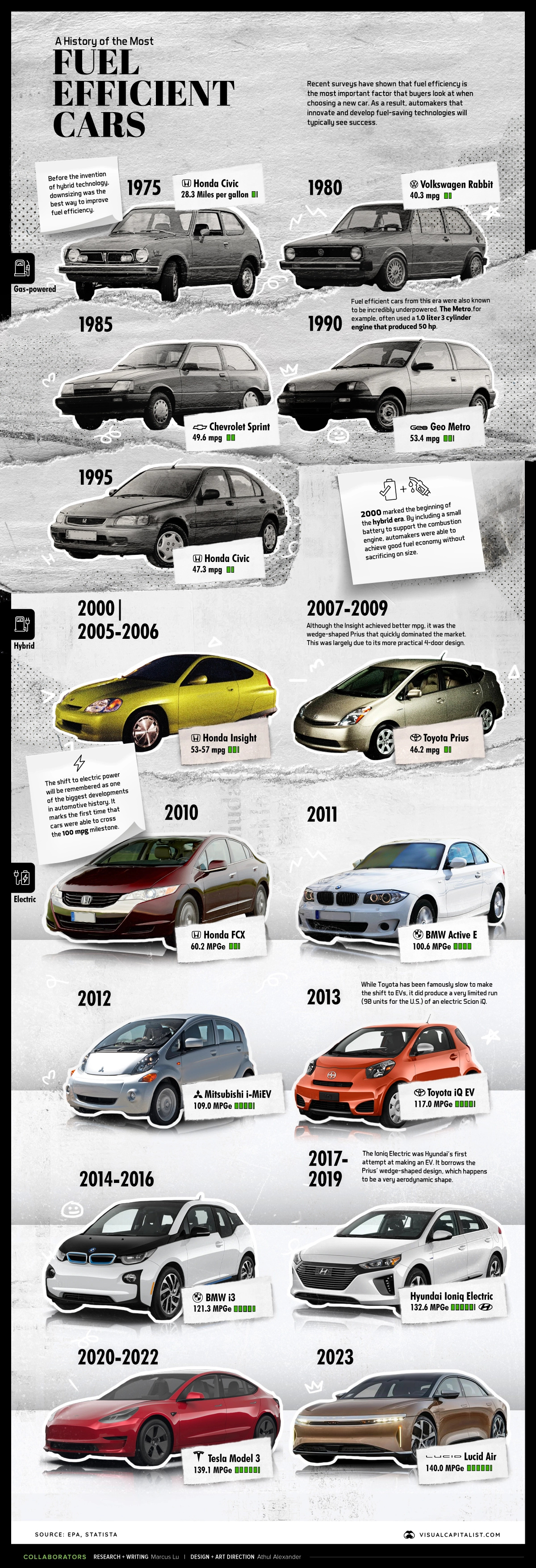What is the most important factor you would look for, when
shopping for a new car? Statista states that it is neither design nor quality,
and not even safety, it is fuel efficiency.
Due to this reason, auto manufacturers are always looking
for clever ways to improve gas mileage in their cars. Beating the competition
by even the slightest of margins can give valuable bragging rights within a
segment.
This infographic uses data from the 2022 Automotive Trends
Report by EPA to list off the most fuel efficient cars from 1975 to 2023.
In this infographic, we have used data from the EPA’s 2022
Automotive Trends Report to list off the most fuel efficient cars from 1975 to 2023.
The data taken is from a government agency of the United
States, so it skews towards cars sold in North America.
Overview of the Data:
All of the information used in the infographic is listed in
the table below.
|
Model Year |
Make |
Model |
Real World Fuel Economy (mpg) |
Engine Type |
|
1975 |
Honda |
Civic |
28.3 |
Gas |
|
1980 |
VW |
Rabbit |
40.3 |
Diesel |
|
1985 |
Chevrolet |
Sprint |
49.6 |
Gas |
|
1990 |
Geo |
Metro |
53.4 |
Gas |
|
1995 |
Honda |
Civic |
47.3 |
Gas |
|
2000 |
Honda |
Insight |
57.4 |
Hybrid |
|
2005 |
Honda |
Insight |
53.3 |
Hybrid |
|
2006 |
Honda |
Insight |
53 |
Hybrid |
|
2007 |
Toyota |
Prius |
46.2 |
Hybrid |
|
2008 |
Toyota |
Prius |
46.2 |
Hybrid |
Three individual approaches to maximize fuel efficiency can
be categorized from this set of data.
Downsizing:
Prior to 2000, the best way for automakers to achieve good
fuel efficiency was by downsizing. Making cars smaller (lighter) meant they
could also be fitted with very small engines.
For example, the 1985 Chevrolet Sprint was rated at 49.6
MPG, but had a sluggish 0-60 time of 15 seconds.
The Concept of Hybrid Vehicles:
The 2000 era saw the introduction of a new concept of hybrid
vehicles. Cars like the Honda Insight and Toyota Prius were mass-market hybrid
vehicles in the early 2000. By including a small battery to support the
combustion engine, automakers could achieve good MPGs (Miles per Gallon)
without sacrificing so heavily on size.
While the Insight achieved better fuel economy than the
Prius, it was the latter model that became synonymous with the term “hybrid”.
This was mainly because the Prius had a more practical 4-door design.
The Prius may have dominated the hybrid market for a long
time, but it too has run into troubles. Its sales started declining since 2014,
even setting historic lows in recent years.
There are several reasons behind this trend, with one being
availability of widespread hybrid models from other brands. The release of the
Tesla Model 3 is also an important factor that cannot be overlooked. It began
shipping to customers in 2017.
Electric Vehicles (EV):
We are at present in the middle of a historic transition to
electric vehicles. However, because EVs do not use fuel, the EPA (Environmental
Protection Agency) had to develop a new system called MPGe (miles per gallon of
gasoline-equivalent).
This new metric system gives us the ability to compare the
efficiency of EVs with traditional gas-powered cars. An essential assumption of
MPGe is that 33.7 kilowatt-hours (kWh) of electricity is comparable to the
energy content of a gallon of fuel.
The most fuel efficient car that can be bought today is the
2023 Lucid Air, which achieves 140 MPGe. Close to this efficiency is the 2023
Tesla Model 3 RWD, which is rated at 132 MPGe.
Infographic by: visualcapitalist


